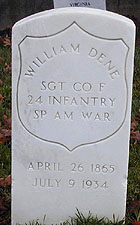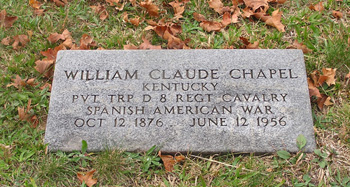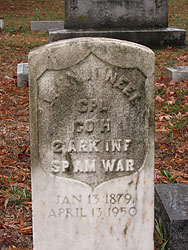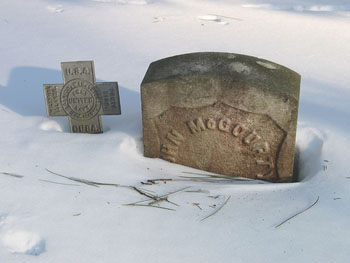
How to Read a Spanish American War Gravestone
By Patrick McSherry
Is This Website Helpful?
Use the Button to Put a Tip in our Virtual Tip Jar!

Please Visit
our Home Page to learn more about the
Spanish American War
Contribute data to the Spanish
American War Veteran Gravesite Recording Project! Click
here to find out how!
Want to know how to
research a Spanish American War veteran, click
here to find out how!
General:
How to read a gravestone? Really? How tough can it be? There are only
a few lines of basic information, right? Well, actually, many people
misunderstand the data given on a Spanish American War gravestone, and
make assumptions that are not correct. This article will help you to
read the gravestone and actually understand its data by clearing up some
of the most common issues.

The
gravestone reads "SP AM WAR" but is the veteran
truly a Spanish American War Veteran? The only way to
know if to do some additional research!
1. “It says ‘SP AM
WAR’ right on it…whatdya mean he didn’t serve in that war?? (This
statement is usually followed by an implied “you jerk”).
This is a big misunderstanding concerning gravestone of the Spanish
American War period. Yes, veterans who served in the Spanish American War
could receive a government-supplied stone (such as that above), and it
would indicate “SP AM WAR” for Spanish American War. Here’s the kicker –
veterans who served in other conflicts, namely the Philippine American War
and the Chinese Relief Expedition (“Boxer Rebellion”) could also apply for
government gravestones, and their stones will also indicate “SP AM WAR”
even though they may not have served in that conflict.
Some background is needed to understand this blatant bit of misinformation
that can literally be carved in stone. The Spanish American War lasted
from April 25 until December 10, 1898. It began with the declaration of
war, and ended with the Treaty of Paris. After December 10, 1898, we were
at peace with Spain. A few months later, on February 4, 1899, war broke
out between former allies - the American and Filipino forces. The U.S.
initially thought this was just a small mop-up affair, but it grew into a
much more bloody war than the Spanish American War. This conflict went on
for years. It officially ended on July 4, 1902, but fighting actually
continued well into 1906. Initially, the Philippine American conflict was
fought by the troops already present, who had just also fought in the
Spanish American War. It is important to realize that this war was a
separate conflict from the Spanish American War. Why? Spain was not
involved! We were fighting against a former defacto ally, the Filipinos.
The war was local to the Philippines and was not a worldwide conflict as
was the Spanish American War.
The Chinese Relief Expedition lasted from 1900 to 1901 and occurred in
China. In short, it had no relation to the Spanish American War.
That all said, why do the government-supplied gravestones for the veterans
of the Philippine American War and the Chinese Relief Expedition lie and
list “SP AM WAR?” It has to do with pensions. Congress set up a fund out
of which veterans of the Spanish American War could receive a pension.
When the Philippine American War started, those men initially fighting in
it had served in the Spanish American War. These men, of course, received
pensions from the same fund. As new troops arrived in the Philippines who
had enlisted after December 10, 1898, they certainly were also entitled to
pensions. The government continued paying pensions to these men out of the
same fund and classed them as Spanish American War veterans though they
technically were not since
they joined after the Treaty of Paris was signed ending the Spanish
American War. The Chinese Relief
Expedition veterans, some of which had also served in the Spanish American
War, were just thrown into this same category. No separate pension funds
were set up for either the Philippine American War vets or the Chinese
Relief Expedition vets. Bureaucracy being what it was, if a man received a
Spanish American War pension, then all of their documentation had to list
“Spanish American War” for their service even if they did not exactly
serve in that conflict, since that is the fund out of which their pension
was paid. So, yes, your Philippine American War veteran relative’s pension
papers will also list him as a Spanish American War veteran incorrectly.
The government-issued gravestone is a government document. It follows the
same line of reasoning and will list the veteran as a Spanish American War
veteran because that is the fund out of which his pension and gravestone
expenses were paid and what all of his paperwork stated while he was
alive, not because he served in that conflict.
How can you find out if the person served in the Spanish American War.
Often it can be simple. Here are the solutions:
A.
Check
what military unit is listed on th e gravestone. If it was a unit that
only existed during the war – like the state units or certain U.S.
Volunteer regiments - the problem is solved. If the unit is part of the
standing army, navy or marines, then you will have more work.
B. You can check our online rosters. If your relative shows
up, he was a Spanish American War Veteran.
C. Check other sources
to find the date of enlistment. If the period of enlistment spans any
part of the Spanish American War, he is a Spanish American War veteran.
And no, it does not matter that he never left the U.S.!
2. Unit Designations – Let there be order!
Understanding the military unit designation on a gravestone can be very,
very confusing! The order of the data on the stone, and some other clues
can solve the problem.
First, if a gravestone reads “David Wastusi, Ohio, 6th Infantry,” that
does not mean the same as “David Watusi, 6th Ohio Infantry.” The first
case, with the state name preceding the unit, means that this gent listed
Ohio as his home state when he enlisted in the 6th U.S. Infantry (the U.S.
is implied since a state is not listed in the unit designation). The
second, with the state name in the unit designation, means that the gent
enlisted in the 6th Ohio Volunteer Infantry.


The gravestone at left has the state name before the unit
designation.
The gravestone at right has the state name in the unit designation.
The 6th U.S. Infantry and the 6th Ohio Volunteer Infantry were entirely
separate military units that briefly co-existed. The U.S. regiments (units
with just U.S., a number and a branch – artillery, infantry or cavalry)
were part of the “regulars” or the standing army. These regiments existed
before the war, and continued to exist after the war. They were usually
the best trained, and were professional soldiers. They did not like to be
confused with the state or national volunteers, whom they considered to be
untrained rabble for the most part.
Keep in mind that “volunteer” has nothing to do with actually volunteering
versus being drafted. There was no conscription in the Spanish American
War era (and even when there was, during the Civil War, the regiments were
still listed as “volunteer” even if not all of the men actually intended
to be there). The word “volunteer”- often abbreviated “Vol.” - is
used to differentiate between the regular standing army units and the
temporary regiments, usually raised by a state and turned over for use by
the federal government for the period of the war, such as the 6th Ohio
Volunteer Infantry.
So…word order is important. If the state precedes the number, the regiment
is a U.S. regular army regiment. If the state name comes after the number,
it is a volunteer regiment from a state. If you do not understand
particular abbreviations, we explain them here
There is a confusing set of regiments that cause particular problems.
These are the U.S. Volunteer regiments, such as the 1st
U.S. Volunteer Cavalry or the 9th U.S.
Volunteer Infantry. Note that the word “volunteer” appears
prominently in these unit designations. The 1st
U.S. Cavalry and the 1st
U.S. Volunteer Cavalry are
not the same unit. The first – with no “volunteer” in the designation -
was, again, a regiment of the regular, standing army that existed before
the war, and would continue to exist afterwards. The 1st U.S. Volunteer Cavalry
was a very temporary regiment that existed for only a few months (in fact,
this regiment was also known as “Roosevelt’s Rough
Riders,” and is legendary). The two co-existed, but were not the
same unit, and had entirely different histories and were made up of
different groups of men.
The U.S. Volunteer regiments had this odd designation because they were
temporary “volunteer” regiments like the state regiments, but they did not
come from one particular state. They were recruited from various locations
across the nation, hence the “U.S.” designation rather than a state
designation. There were only sixteen of these regiments in the Spanish
American War, as follows:
The 1st
through 10th U.S. Volunteer Infantry regiments
The 1st through 3rd U.S. Volunteer
Cavalry regiments
The 1st through 3rd U.S Volunteer
Engineers
So, in short, if the inscription reads both “U.S.” and “volunteer,” it was
one of these regiments. Also keep in mind that “volunteer” can be
abbreviated “Vol.” In some cases the U.S. Volunteer regiment designation
is abbreviated as “U.S.V.” Therefore the 9th U.S. Volunteer
Infantry can be listed as the “9th
U.S.V. Inf.” for example.
3. Companies, Batteries and Troops, Oh my!
After the main unit designation, there is often a listing of the military
branch – infantry, artillery or cavalry.
Just to clarify a question we receive, infantry were the gents who
individually fire longarms, like a rifle. An infantry regiment –
abbreviated “inf,” consisted of nine to twelve companies of men. Company
is designated by a letter, so you may find the “4th PA Vol. Inf. Co. L”
which is the 4th Pennsylvania Volunteer Infantry,
Company L.
The artillery fired cannons and is abbreviated “art.” At times you
may see “L.A.” or “H.A.” which refers to “light artillery” and “heavy
artillery”. Light artillery is the type of artillery that the army would
take with it in the field. Heavy artillery was generally too big for being
pulled around, and was stationary in fortifications. A light artillery
regiment is divided into nine to twelve “batteries” also designated by a
letter, so we may have the “7th U.S. Art., Batt A” for the 7th U.S.
Artillery, Battery A. HOWEVER, the space is tight on a gravestone, so
usually, even though it is incorrect, often “Co.” is substituted for
“Batt.” So, you will more typically see something like “7th U.S. Art., Co.
A” even though a light artillery regiment does not have companies! Co. A
refers to Battery A. Heavy artillery is similar, though heavy artillery
often also received infantry training as well as artillery training. In
some cases heavy artillery regiments were officially made of companies,
while at other times, of batteries. Heavy artillery was rare during the
Spanish American War, so don’t fret about it.
Then we have the cavalry – and please note that the letter “v” occurs
before the letter “l” in the word “cavalry.” These were the men who
generally fought on horseback, or theoretically used their horses to
rapidly deploy onto a battlefield. Most of the cavalry regiments who made
it to the front during the war went into battle without horses. Terrain,
tight trails and high amount of fodder needed for horses made horses
somewhat impractical on a large scale. However, these units were “cavalry”
not “calvary.” Calvary is where Jesus was crucified. Cavalry are men on
horses.
Whereas infantry regiments have companies and artillery regiments have
batteries, cavalry regiments consisted of nine to twelve “troops.” Troops
are also designated by letter, such as “Troop F,” Those of you familiar
with old television shows will remember the comedy about an old west
cavalry unit which was called “F Troop,” which is how a cavalry troop was
usually referred to...letter first.

This
grave
has the Spanish American War Cross
flagholder...but that does not mean
it is definitely a Spanish
American War grave. To find out,
uncover the unit
designation!
4. The Migratory Practices
of flag holders.
Another thing that leads people astray is
not on the stone itself... it is the flagholder often put at a veteran’s
grave. In the case of the Spanish American War, the flagholder is in the
shape of the symbol of the United Spanish War Veterans (U.S.W.V.), which
was an equal-armed cross, like that of the Red Cross. Theoretically, these
flag holders are placed beside the veteran’s grave so that a flag can be
placed there.
The problem is that flag holders are not reliable. The flagholder was
placed at the grave years ago. When the gent with the lawn mower comes
through, does he mow around it? No, he removes it, mows and replaces it.
For a typical flagholder, this may have occurred hundreds of times. Often,
when the flagholder is put back, it moves a bit. Soon it is unclear what
grave it is associated with, especially if the original gravestone was a
family stone (as opposed to a government-supplied stone), and does not
list the unit, but only a name. The flagholders, especially in the
pre-weedwacker age, have migrated like Monarch butterflies. The author has
seen World War Two flagholders on the graves of females who died in the
mid-1800’s and a Revolutionary War flagholder on a World War Two veteran’s
grave. Also, at times those installing the flagholders used whatever
flagholder they had in stock...and it may represent the correct conflict.
A Spanish American War flagholder is an indication that a Spanish American
War veteran may be nearby, but just because it is beside a specific stone
does not guarantee that the stone was that of a Spanish American War
veteran. More evidence is needed. Check around, check rosters,
and check records!
Once you verify that you have found the grave of a Spanish American War
veteran, submit that information to have it listed on the National
Spanish American War Veterans' Gravesite Recording Project.
Click
here to visit the Website Bibliography ||| Click
here to visit the Website Video Bibliography
Dewey's
Flagship, OLYMPIA needs your help!! Click here
to learn how you can help!
Support
this
Site by Visiting the Website Store! (help
us defray costs!)
We are providing the following
service for our readers. If you are interested in books, videos, CD's
etc. related to the Spanish American War, simply type in "Spanish
American War" (or whatever you are interested in) as the keyword and
click on "go" to get a list of titles available through Amazon.com.
Visit Main Page for
copyright data
Return to Main Page
Return to Researching a Spanish
American War Veteran Page





